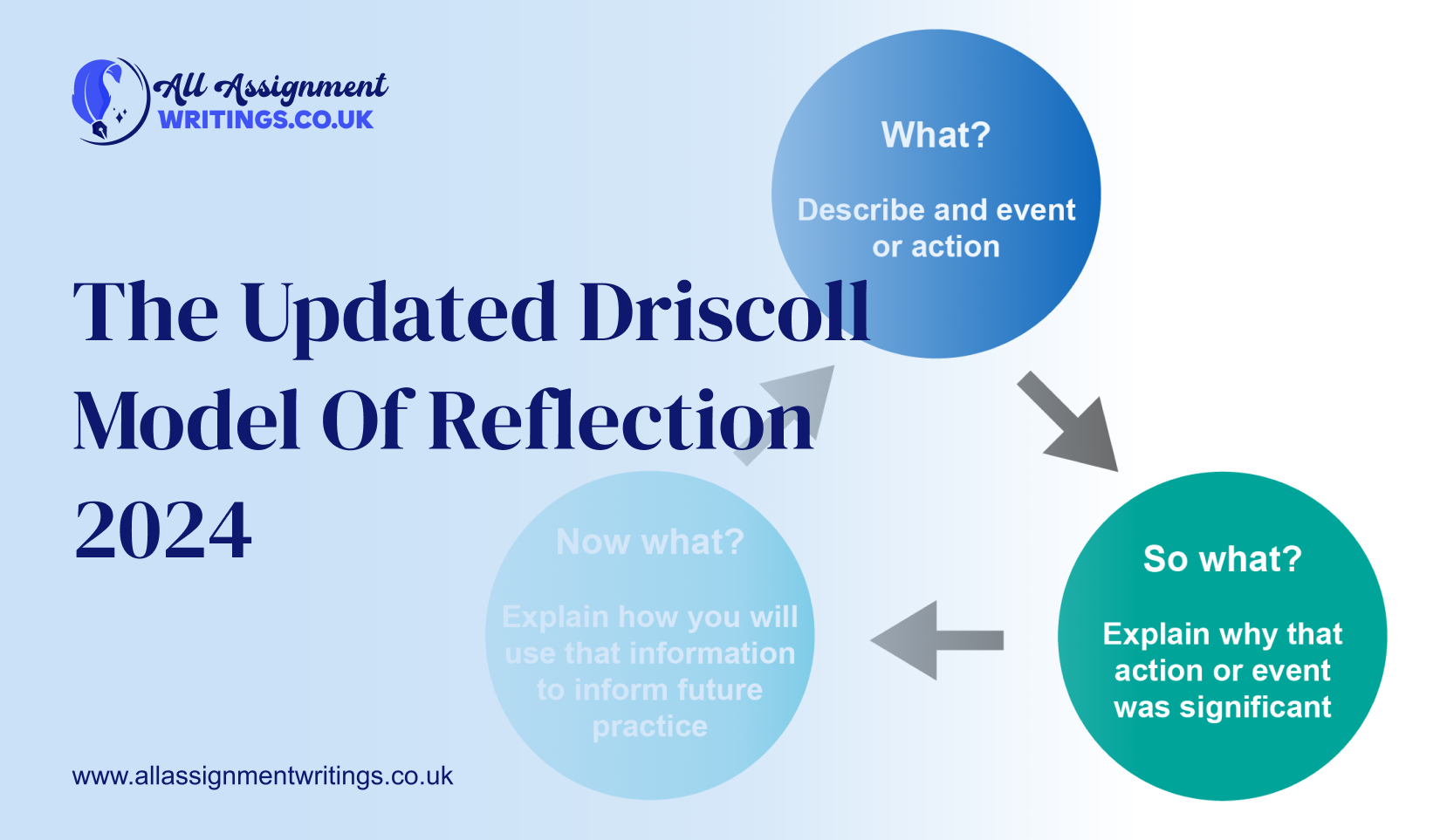The Driscoll Model of Reflection is currently recognized as one of the most effective models of self-development that can be successfully used across disciplines. Developed by John Driscoll in 1994, it provided a systematic approach to how one can review events and come out with lessons to be learned. This paper aims to outline the model’s main attributes, identify its advantages and limitations, and define its applicability from the perspective of the year 2024.
What is called Driscoll’s Model of Reflection?
Driscoll’s model is a cyclical model consisting of three cycles, also known as the content, perspective, and application cycles, occasionally referred to as the ‘What’, ‘So What’, and ‘Now What’ cycles. These stages make the user to reflect on the experience from several perspectives, enabling him to come up with the best way to learn from the experience.
What? This stage entails a consideration of details regarding the experience in question. It prompts questions like:
- What happened?
- Who was involved?
- Where and when did it happen?
- How did you feel and what did you think during those first moments?
- So What? This stage focuses on the understanding of the experience as it is.
- What happened and its implications?
- Moreover, what kind of feelings did it cause?
- Were there any factors or theories that could have been the root of the cause of the situation?
- To what extent does this experience align or differ from prior experiences or prior knowledge one may have?
- Now What? This final stage promotes a future-oriented mindset. Individuals consider:
- What do you think might be learned from this experience?
- What can be done to enhance the ability to apply these learnings in future scenarios?
- What adjustments do you or may you need to make to your practice or approach going forward?
Comparing Driscoll’s Reflective Model to that of Driscoll’s 1994 Model of Reflection
There are two models that are often described in different names, namely “Driscoll’s Reflective Model” and “Driscoll’s 1994 Model of Reflection. “ Some sources distinguish them, but basically, the structure and the stages are the same. Once again, the ‘1994’ is the numeric representation of the year when the model was originally introduces.
Driscoll Model of Reflection Pros and Cons:
This Ofeco is a balanced view of the program, and provides a clearer picture of the positive aspects of the program that have been otherwise overshadowed by its flaws.
The Driscoll Model offers several advantages:
Simplicity and Ease of Use: The proposed three-stage management structure is logical and comprehensive, and thus it can be used in different developing circumstances. For this reason, and for its applicability to patient care, Nursing Assignment Help UK specialists often suggest this model to student nurses.
Structured Learning:
This means the model provides a peculiar structure focusing on the aspects of the experience which is important.
Promoting Critical Thinking:
The ‘SWOT’ analysis helps in critical thinking about the probable ‘So What’ of a given situation, which unfolds self-awareness.
Actionable Learning:
The last step causes reflection to be a powerful tool by sparking the process of applying the learnings in the future.
However, limitations also exist:
Linear Structure: The reconnoitering steps of the model are however somewhat linear which may be limiting in real-life scenarios where an insight may be identifies further on in the reflection process.
Limited Scope:
The model is primarily geares towards C’s experience and could thus be limits by not taking into account the surrounding context.
Oversimplification:
Critics have claimed that the model may not capture emotions fully, thus the reflective process more than it should.
Why Pt?
Even though there are certain weaknesses in using the Driscoll Model, it can still be regarding as rather helpful in terms of reflecting, for example, due to its rather rough structure and easy applicability. Here are some compelling reasons to utilise this model:
Individual and Professional Development:
Reflecting is a vital step in the development of a person both at the personal and the working level. Education enhancement involves the Driscoll Model – this being an Idea to structure Experience Analysis.
Improved Decision-Making:
It is through observing the previous results from certain actions that people get to learn how to avoid or replicate them in the future.
Enhanced Communication:
Helps in Reflecting on Possible personal experiences can lead to an enhanced understanding of the importance of positive communication. Cognitive development allows individuals to express thoughts and feelings in a clearer manner or at least to the best of one’s ability enabling them to effectively teach and pass down lessons to other members of the society.
Adaptability in a Changing World:
The world is not static and it’s very important to learn as much as possible about one’s environment so as to be ready to adapt to changes. The reflection incorporated in the Driscoll Model enables the person to work better and prepares him or her for changes.
The strengths of using the Driscoll’s Model of Reflection can be explains as follows:
As we move toward the future, it is crucial to assess the significance of ICT in the year 2024.
Thus, the key and distinct feature of the Driscoll Model is the ability to flexibly develop new kinds of lessons. It is important to note that IFR was develop in 1994 nonetheless, the basic principles of reflection are as follows in 2024. But, the question arises can we make it better than it is at the moment?
Changes that can be make for a more contemporary outlook
Here are some suggestions to consider for a potential update to the Driscoll Model:
Incorporating Technology: In this section, the intent is to show how this aspect may be supporting by incorporating the use of technology in the context of the reflective process. For example, remembering the event in a ‘note-taking’ format, or recording emotional feelings at a specific place.
Acknowledging Emotions: Adding a supplementary kind of space that focuses specifically on how an experience may emotionally affect a person could help broaden the existing model of reflection.
Contextual Awareness: Trying to come up with an explanation of what may have happened and why the individual’s life is not so good, perhaps exploring factors that exist beyond the situation that concerns them at the moment would be helpful, and might provide a different perspective on the topic.
Collaborative Reflection: Ironically, the current model inclines more toward individual reflection. Perhaps, one could encourage reflection with other members of staff or learners so that the different aspects are discovers and learning is broadening.
Beyond the Model: In the tradition of encouraging reflective practice, this article presents one supportive writing structure: the teacher’s reflective journal. However, in addition to following the Driscoll Model, it is needs to work out a real habit of reflection. This involves:
Creating Dedicating Time: Similarly, make sure that there is some time allocating for thinking, for as short as an hour a day.
Maintaining a Reflective Journal: It also assists in being able to look back at events and shared time so that one can recall them at a later date.
Seeking Feedback: Consult with other people and ask for their comments on what you did, what went well. What went wrong, and what can be improves, thus enriching your reflection practice with other people’s insights.
Openness to Learning: Implementing a positive attitude toward reflection as a growth-oriented process. Enables one to comprehend oneself and the experiences more profoundly.
Conclusion: The Purpose and Sustainability of Reflection
In conclusion, it could be notes that while the Driscoll Model does have its drawbacks. It is still highly useful when it comes to structured reflection. Familiarizing oneself with its advantages and disadvantages makes it possible to use its benefits and think about additional modifications. That would be useful to have in an increasingly diverse environment. A realistic practice of reflection which includes the main aspects of the Driscoll Model, as well as other recommendations. Enables learners and professionals to develop a variety of skills when facing a number of challenges.
Further Exploration:
In this article, the reader has been affording an understanding of the basics of the Driscoll Model.
Kolb’s Experiential Learning Cycle: This framework provides another perspective on reflection and emphasizes its cyclic process of learning from experience.
Schön’s Reflective Practice: This theory has gone further in exploring the issues related to reflection in professional practice.
Mindfulness Techniques: Incorporating some form of mindfulness into the reflection process can help foster self-awareness and emotional processing.
Using the Driscoll Model as a framework while incorporating other tools and strategies. People can develop a deep and engaging reflective practice. Using that reflective practice to become the best version of themselves in 2024 and beyond.








